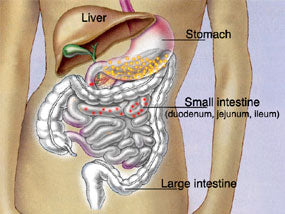 Trusted Brand for Over 25 Years
Trusted Brand for Over 25 Years Made in New Zealand
Made in New Zealand 365 Days Guarantee
365 Days Guarantee Trusted Brand for Over 25 Years
Trusted Brand for Over 25 Years Made in New Zealand
Made in New Zealand 365 Days Guarantee
365 Days GuaranteeFor most of our complex formulas we utilize an advanced delivery technology. This delivery system is known as an enteric coating. This is usually only used with advanced pharmaceutical products.
The enteric coating that we use contains a pH sensitive polymer, which means that it remains intact in the acidic environment of the stomach (pH 1.5 - 3.5), protecting the contents of the tablet.
After passing through the stomach the coating then disintegrates in the small intestine (duodenum) which has an alkaline environment (pH 6.5 - 7.6).
The enteric coating is inert and simply passes through your system without any effect at all. The coating we use is manufactured by Colorcon, a world leader in the development and manufacturing of delayed and immediate release coatings for both pharmaceutical and dietary supplement products. This coating has been thoroughly proven for both safety and efficacy.
Apart from the protection that this system provides for those ingredients in our enteric coated products which could be damaged by stomach acid, it also prevents any irritation of the gastric mucosa in the stomach, which is common with many supplements and drugs.
We only enteric coat those products which contain ingredients that are sensitive to stomach acid such as SAMe and various other nutrients. That is why not all our products are treated this way. The enteric coating process is very expensive and complex and as such there has to be a valid reason for doing it on each product.
Xtend-Life uses the state of the art Nutrateric II coating developed and produced by Colorcon specifically designed for use with dietary supplements. Xtend-Life is proud to be the first manufacturer in the world to use this system.
We believe that Nutrateric II is the most natural form of enteric coating on the market. This coating is mainly plant derived. This coating is clear, and this means that there is no iron oxide or titanium dioxide or any other compound included to provide colouring. Nutrateric II only includes one synthetic ingredient, ammonium hydroxide, which is used to stabilize the solution and disperse the particles within the material during the coating process. This ingredient is recognised as safe by the US FDA (included on the FDA’s GRAS list) and other regulatory authorities around the world. Nutrateric II is an aqueous (water) based system.
Full list of ingredients in the Nutrateric II enteric coating:
Ingredient |
Source |
|
|---|---|---|
| Purified water | Natural | Meets national water standard criteria |
| Ethylcellulose | Vegetable | Extracted from wood pulp |
| Ammonium hydroxide | Synthetic | |
| Medium chain triglycerides | Vegetable | Extracted from coconut and/or palm kernels |
| Oleic acid | Vegetable | Extracted from Palm and tall oils |
| Sodium Carboxymethyl cellulose | Vegetable | Extracted from wood pulp |
| Talc | Mineral | |
| Polydextrose | Vegetable | Extracted from corn |
Each batch of tablets is tested for disintegration using protocols set out by the British Pharmacopeia. These tests are conducted using specialist equipment. The following are typical of the test results:
After the tablet has been swallowed it is transported by peristaltic contractions of the oesophagus into the stomach. The stomach is a pouch-like structure that serves as a food reservoir during early stages of digestion. The stomach churns and gyrates to mix (food / tablets) with digestive secretions such as the enzyme pepsin and hydrochloric acid (stomach acid).
However, the Xtend-Life’s enteric coated tablets are not affected by the stomach acid. In general food stays in the stomach from about 45 minutes up to 2 hours.
It then is transported into the upper, small intestine, called the duodenum. The "small" intestine is about 20-23 feet long and consists of 3 segments, the duodenum (22 cm or 10 inches long), the jejunum and the ileum. In the small intestine the tablet releases its ingredients in approximately 20 - 60 minutes in the more alkaline environment. The ingredients are absorbed through the intestinal wall…into the bloodstream.
Additional enzymes are added to our enteric coated tablets to further help the breakdown of certain nutrients. This is not practical for non-enteric coated tablets because the enzymes would be damaged by the stomach acid. Absorption of minerals occurs mainly in the duodenum; absorption of water-soluble vitamins, carbohydrates and proteins occurs in the jejunum; and the ileum absorbs fat-soluble vitamins.
The pancreas secretes pancreatic enzymes into the small intestine, consisting of lipases, proteases and amylases. Lipase helps absorb fat-soluble vitamins. Amylases break down starch. Proteases (trypsin, chymotrypsin and carboxypeptidase) break down protein molecules into single amino acids.
The liver produces bile, important in the absorption of fats, oils, and fat-soluble vitamins. The common bile duct and the pancreatic duct connect with the jejunum to transport these substances into the small intestine. The inactive components of the tablet (the inert excipients and the fragments of the enteric coating) combine with the waste products from food and are transported into the colon or large intestine (which is about 1.5m or 5 feet long), and then continue to pass out of the body.
When you swallow a 'normal' good quality tablet, capsule, or take a liquid supplement this is what happens:

Figure 1
None of the active ingredients are released in the stomach as in the above illustration. Instead they are released in the small intestine as indicated in red with only minimal loss (Fig 2).

Figure 2
Shipping calculated at checkout